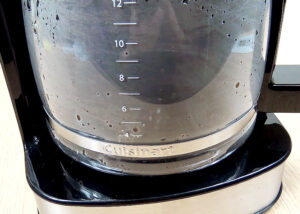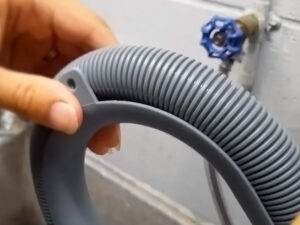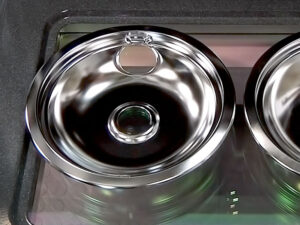Our everyday life depends on the kitchen faucet for water for cooking and cleaning. The faucet head’s performance and look might be affected by mineral deposits, filth, and stains over time. Vinegar is a common and effective cleaning remedy, however, some people prefer other techniques or don’t have any.
This guide explains how to clean a kitchen faucet head without vinegar. We’ll discuss gentle but effective methods and cleaning products to restore your faucet head to its former glory. We have natural cleaners like lemon juice and baking soda and specialist cleaners. Learn how to clean and maintain a kitchen faucet head without vinegar to keep it working and looking good.
What Is a Kitchen Faucet Head?
A kitchen faucet head is an integral part of a sink. When the tap is turned on, water flows from it. Think of it as the business end of your kitchen sink, where you get fresh water for cooking, cleaning, and drinking.
A faucet head has a spout or nozzle where water escapes and a handle or lever to adjust water flow and temperature. Faucet heads can be elegant and futuristic or traditional. To endure regular use and water exposure, they are usually composed of stainless steel, brass, or chrome.
A kitchen faucet head’s main job is to supply water on demand. The faucet head distributes hot, cold, or in-between water when you crank the handle. This makes cleaning dishes, rinsing veggies, filling pots, and even getting a glass of water easy.
Modern faucet heads often have extra functions to improve their functionality. Many faucet heads may be swiveled around the sink to direct the water where you need it. Pull-out or pull-down sprayers are useful for dishwashing and sink cleaning. These sprayers include forceful jets for tough food residue or gentle aerated flows for sensitive operations.
Faucet heads can also have water-saving technologies. Sensors in certain models turn the water on and off when your hands are under the faucet to reduce waste. Others use less water and maintain water pressure via flow restrictors or aerators that combine air with water.
The efficiency of your kitchen faucet head depends on its maintenance. Mineral deposits and debris from your water supply might slow faucet flow. Regular cleaning prevents buildup and extends faucet head life. Clean with gentle soap and water or vinegar, whichever you want.
Why Is It Important to Clean a Kitchen Faucet Head Regularly?
It’s important to clean the head of a kitchen faucet often for several reasons:
Keeping the Water Clean
Mineral layers, sediment, and small pieces of trash can build up inside the faucet head over time. If these pollutants aren’t taken care of, they can change the quality of the water coming out of the faucet, giving it a bad taste or smell.
Preventing Clogs
Buildup in the tap head can stop water from flowing, which can cause the water pressure to drop. This can be annoying when you’re trying to do things fast, like rinse dishes or fill pots. Regular cleaning stops these clogs and makes sure that water flows smoothly and steadily.
Make a Faucet Last Longer
Faucets are an investment, and regular care, like cleaning the head, can help make them last longer. By preventing mineral growth and corrosion, the faucet will work for longer and won’t need to be replaced as often.
Improving the Look of Your Kitchen
A clean faucet head adds to the general look of your kitchen. Mineral deposits and spots on faucet heads can make the whole sink area look dirty. Cleaning the kitchen often helps keep it clean and nice.
Using Less Water
Some tap heads, like those with aerators, are made with features that save water. If garbage gets stuck in these parts, they might not work as well. Cleaning the tap head makes sure that these water-saving features work as well as possible, which saves water and reduces waste.
Stop Bacteria From Growing
If you don’t clean the area around a tap head well, bacteria and mold can grow there. Cleaning often stops dangerous microorganisms from growing, making the kitchen a healthier place to be.
Avoiding Expensive Repairs
If you don’t do upkeep, like cleaning the faucet head, it can lead to bigger problems over time. Mineral buildup, for example, can cause corrosion of the faucet’s internal parts, which could lead to leaks or the need for repairs. Regular cleaning can help you find and fix small problems before they turn into big ones.
Making Sure the Water is Safe to Drink
If you drink water from your kitchen tap, it is very important to keep the faucet head clean. Contaminants or germs that have built up in the faucet head can make the water you drink less healthy.
Sustainability
Cleaning the faucet head often fits in with attempts to be green. It cuts down on the need for harsh chemicals to clean, saves water by keeping the flow steady, and makes the faucet last longer, reducing the environmental effect of making and throwing away the faucet.
How to Clean Kitchen Faucet Head Without Vinegar
Cleaning your kitchen faucet head without vinegar is easy with the appropriate method. These ten simple procedures will clean your faucet head whether you’re out of vinegar or prefer other techniques. Get rid of mineral deposits, filth, and buildup for a clean, effective faucet.
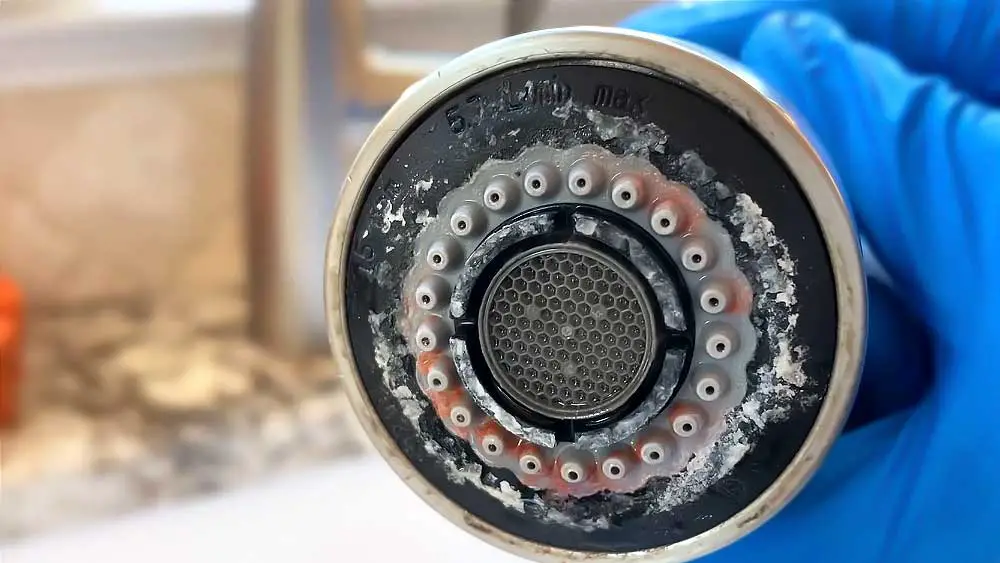
Get Supplies
Prepare the necessary cleaning supplies to start the job. Prepare a small basin and an old toothbrush or soft-bristle brush. Having liquid dish soap on hand is essential for breaking down dirt and mineral buildup. A wrench if your faucet head is removable, a microfiber cloth or sponge to wipe away filth and residue, and fresh lemon juice to replace vinegar in the cleaning process is also needed. Organizing and keeping everything close will make cleaning easier.
Turn Off Water
Before cleaning, take care to avoid unexpected water flow. Turn off your faucet water at the shut-off valves under your sink. This simple but vital procedure will keep the faucet head clean and dry while preventing water splashes and leaks.
Remove the Faucet Head If Possible
Lucky you if your faucet head is removable! This procedure simplifies cleaning greatly. Wrenching the faucet head from the fixture is delicate. You’ll have better access to every corner, making it easier to remove tenacious mineral deposits and filth that have collected over time. If your faucet head isn’t removable, there are other ways to clean it.
Soak Faucet Head
After preparing your faucet head for cleaning, soak it. Fill a small bowl with warm water. Create a soapy solution using a few drops of liquid dish soap. Cover the faucet head with this solution. Soaking it for 10-15 minutes helps dislodge debris and mineral deposits that dull your faucet head.
Clean with a toothbrush
Step up and get to work after the soak. Get an old or soft-bristle toothbrush. These tools are ideal for gently scrubbing away leftover filth, especially in tight spaces with mineral deposits. Avoid damaging the faucet’s finish by being thorough yet careful with this procedure. To restore its gloss and cleanliness.
Thoroughly Rinse
After scrubbing, rinse the soap and filth. If your faucet head is removable, hold it under running water to remove residue. Wipe non-removable faucet heads with a clean sponge or towel soaked in clean water. This procedure removes soap and dirt from your faucet head, preparing it for the next cleaning.
Lemon Juice Magic
Instead of vinegar, fresh lemon juice can remove mineral deposits. Gently rub the faucet head with fresh lemon juice using a cloth or sponge. Natural cleaning agent citric acid breaks off mineral buildup in lemon juice. Let the lemon juice linger on the faucet head for a few minutes to clean and fragrance it.
Rinse Thoroughly
Lemon juice is followed by another thorough rinse. Remove any lemon juice and mineral deposits. To get a dazzling faucet head, rinse it well with clean water. The faucet will look better and smell fresher after this process.
Reattach the Faucet Head
Reinstall the faucet head if you removed it. Reattach it to the faucet fixture using your wrench. A tight, leak-free fit is necessary for faucet functionality. A well-attached faucet head looks beautiful and guarantees steady water flow.
Turn Water On
After reattaching the faucet head, turn on the water. Restart the sink shut-off valves. Test your clean faucet head with hot and cold water. This last step ensures everything works and improves water flow and pressure by removing mineral deposits. Now your kitchen faucet looks great and works great.
These thorough techniques clean your kitchen faucet head without vinegar. Following these steps will restore the faucet’s beauty and operation, keeping it a reliable and shining kitchen fixture. Regular maintenance and cleaning will prevent mineral deposits and filth from accumulating, keeping your faucet in great shape for years.
Alternative Methods for Cleaning Your Kitchen Faucet Head
Although vinegar and lemon juice are popular natural cleaning agents, there are other ways to get the same sparkling results. These alternatives work whether you’re out of vinegar, want a change, or have a specific cleaning problem. Five detailed methods to clean your faucet head and remove mineral deposits and grime are covered in this post. You can choose from baking soda to specialist commercial cleansers to meet your needs.
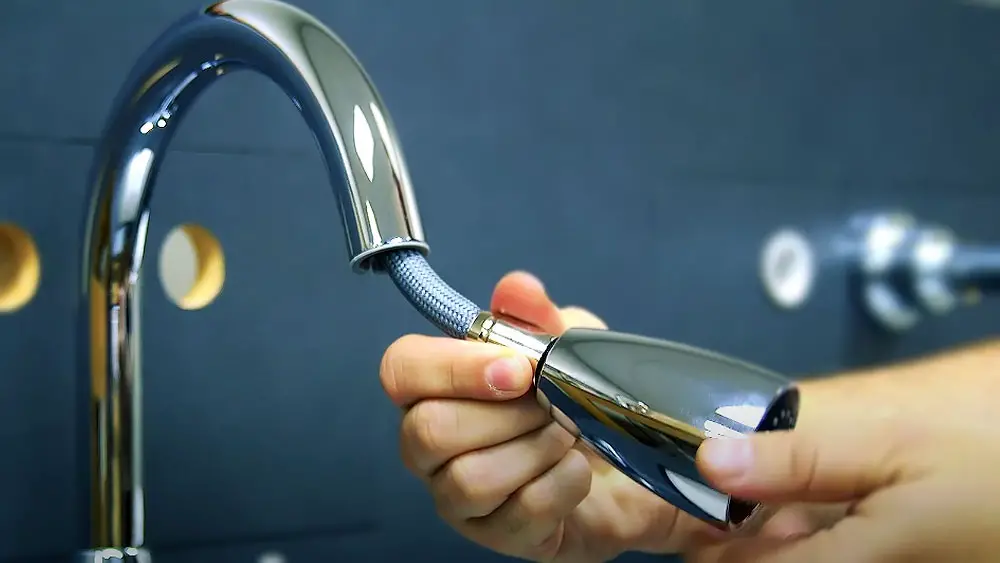
Baking Soda Paste
Baking soda is a versatile and effective cleaner for faucet head mineral deposits. Make a baking soda paste by mixing baking soda and water. Aim for toothpaste-like consistency. Apply paste generously to the faucet head, covering all damaged areas.
Let the paste settle for 15-20 minutes. Baking soda breaks dissolve mineral deposits and stains throughout this period. After the specified time, use an old toothbrush or soft-bristle brush to gently scrape the faucet head, focusing on stubborn buildup. Finally, rinse the faucet head with clean water to remove the baking soda paste and reveal a cleaner, shinier fixture.
Commercial Faucet Cleaners
Consider a commercial faucet cleaner for specialist cleaning. These treatments target mineral deposits and stains without damaging faucet finishes. Follow the product label instructions to use a commercial cleaner successfully. You’ll need to apply the cleaning to the faucet head, covering the afflicted regions.
Let the cleaner sit for the manufacturer-recommended time. This dwell period dissolves mineral deposits with the cleaning agent. After the recommended time, rinse the faucet head with clean water to remove all cleaners. Cleaning your faucet head should make it shine.
Lime or Calcium Remover
Lime or calcium removers can effectively remove obstinate mineral deposits. These goods are available at most hardware and home improvement stores. Since lime and calcium removers are potent, read and follow the directions. The remover should be applied to the faucet head in all mineral accumulation regions.
Let the product sit for the specified time, which depends on deposit severity. The remover will dissolve and break down tough mineral deposits. To remove all cleaning and residue, rinse the faucet head with water after the designated time. This approach is especially successful for tough mineral deposits, restoring your faucet head to its original state.
Boiling Water
If your faucet head is removable, boiling water can remove mineral deposits easily. Start by removing the faucet head. A kettle of water should now be boiling. Carefully insert the faucet head in the kettle after heating the water. Take a few minutes to soak. The boiling water will dissolve mineral deposits.
Tongs carefully remove the faucet head from the boiling water after soaking. Be careful, it’s hot. Brush the faucet head gently to remove residue. Finally, wash the faucet head with cold water to remove mineral deposits and grime. This approach cleans and refreshes faucets with removable heads.
Floss or Toothpick
Dental floss or a toothpick can remove mineral deposits from hard-to-reach regions. This approach works well in fissures and narrow spaces. Carefully insert dental floss or a toothpick into the afflicted areas. Scrape accumulation gently without scratching the faucet’s finish.
This thorough method lets you target trouble areas and eliminate tough mineral deposits. Rinse the faucet head with clean water to remove any residue after flossing or toothpicking. This procedure removes mineral buildup from even the toughest locations, leaving your faucet head flawless.
Including these alternate cleaning methods in your normal maintenance regimen will help keep your kitchen faucet head looking and working great for years.
Cleaning Signs for Kitchen Faucet Heads
A kitchen faucet head can get filth, mineral deposits, and other debris, affecting its performance and look. Signs your kitchen faucet head needs cleaning:
Reduced Waterflow
A decrease in kitchen faucet water flow is generally the first symptom of trouble. This flow decrease is caused by mineral deposits, sediment, or debris in the faucet head’s intricate components. This buildup can restrict water flow over time, making kitchen operations inefficient and frustrating.
Spray Pattern Uneven
A well-functioning kitchen faucet should spray evenly when turned on. Water spraying erratically or in multiple directions may indicate a partially blocked faucet head. This makes dishwashing and vegetable cleaning harder and wastes more water.
Water Spills
When you turn on your faucet and water splatters, it may be a clogged faucet head. The obstacle, usually dirt or mineral buildup, impairs water movement. If left unchecked, this condition can damage your kitchen fixtures and be messy.
Discoloration or Stains
Mineral-rich water can stain or discolor your kitchen faucet head. Once they build, these stains can be difficult to remove and ruin your kitchen’s appearance. Regular cleaning keeps the faucet looking good and polishes the kitchen.
Disgusting Odors
Unexpected scents can result from a neglected faucet head. Bacteria in faucet debris can cause kitchen sink odors. This may harm health and the kitchen’s atmosphere.
Hard Water Buildup
In hard water areas, calcium and magnesium can build up on faucet heads. This chalky, white accumulation can degrade the faucet’s appearance and cause bigger problems over time.
Swivel or Rotate Difficulty
A filthy or clogged head might hinder the convenience of swivel or pull-out kitchen faucets. Meal preparation, dishwashing, and filling large pots can be frustrating due to this restriction.
Noisy Operation
Clogged or mineral-laden faucet heads may make strange noises when turned on or off. These sounds may be disconcerting and indicate underlying concerns.
Visible Debris
Debris may be visible in the faucet head. This indicates cleaning is needed to restore functionality and hygiene.
Reduced Water Pressure
Sudden decreases in water pressure, especially in the kitchen faucet, might delay kitchen tasks. The faucet head’s silt or debris commonly causes this water pressure drop.
Clean your kitchen faucet head regularly to prevent these concerns and maintain its performance. Depending on the faucet head, soaking it in vinegar, cleaning with a brush or toothbrush, and washing carefully can remove mineral deposits and debris. If the problem persists or is severe, replace the aerator or faucet head.
Tips for Keeping the Kitchen Faucet Head Clean and Working Well
Your kitchen faucet is a fixture, delivering water for cooking, cleaning, and other duties. It’s crucial to keep mineral deposits, grime, and other impurities off the faucet head to prolong its life and function. Keep your kitchen faucet head clean and efficient with these preventive tips:

Regularly Clean and Wipe
Wiping down your faucet head with a clean, dry cloth or paper towel may seem insignificant, but it has a big impact. Wipe the faucet head gently after each usage. This simple operation eliminates moisture, water stains, and mineral deposit accumulation. By adding this fast habit to your daily kitchen routine, you may lengthen the time between deep cleanings and keep your faucet head shiny.
Water softeners can revolutionize faucet maintenance in hard water areas. Hard water, rich in calcium and magnesium, can deposit mineral deposits on your faucet head. Water softeners replace these minerals with sodium ions to soften water. Thus, mineral accumulation will be reduced, protecting your faucet head’s performance and attractiveness.
Avoid Harsh Cleaners
Cleaning products are vital to faucet head upkeep. Avoid harsh or acidic cleansers to protect the faucet’s finish. Choose milder cleaners like liquid dish soap, baking soda, or commercial faucet cleaners. These softer solutions remove filth and stains without damaging your faucet head, preserving its condition.
Clean Removable Parts Separately
Aerators and filters are detachable on many faucets. These areas collect mineral deposits, impacting water flow and quality. Detach and clean these components regularly to avoid this. Thus, you can directly address mineral buildup and preserve water flow. This simple but crucial procedure can improve your kitchen faucet’s function and durability.
Buy a Faucet Filter
Installing a faucet-mounted water filter improves water quality and faucet head maintenance. These devices remove minerals, sediments, and pollutants from water. Minimizing dirt and minerals reaching your faucet head will greatly reduce mineral accumulation. Additionally, a faucet filter can improve the flavor and smell of tap water, protecting your health and faucet.
Install Sediment Filter
For well water or areas with high sediment levels, installing a sediment filter in your plumbing is a good idea. Before reaching your faucet head, sediment filters remove sand, rust, and debris from your water supply. This improves water quality and prevents sediment accumulation blockages and faucet damage. Keep particles out of your faucet’s internal mechanisms to improve water flow and save maintenance.
Periodic Deep Cleaning
While everyday maintenance can prevent minor accumulation, your faucet head needs occasional comprehensive cleaning. These sessions should use more thorough cleaning methods like our previous advice. Long-term mineral deposits can be removed via deep cleaning. It revitalizes faucet heads, restoring their shine and water flow. Regular deep cleaning prevents mineral deposits from becoming an issue.
Check for Leaks
Beyond mineral deposits, check your faucet for leaks and drips regularly. Leaks waste water and generate mineral buildup around the faucet head. Water stagnating in cracks can promote mold and mildew growth and mineral deposit formation. Leak detection and repair prevent water damage and faucet maintenance difficulties.
Replace or Repair Seals
If your faucet head leaks around the base, check the seals or gaskets. These rubber components may wear out or break, jeopardizing their watertight seal. Replacing these seals or gaskets is easy and prevents water from seeping beneath the faucet head, preventing mineral accumulation and maintaining performance.
Teach Family Members
All household members must cooperate for faucet head maintenance to succeed. Make sure everyone in your home understands the necessity of a clean faucet head and this guide’s preventive steps. Tell them that disregarding faucet maintenance can cause water flow issues and stains. Encourage everyone to follow these preventive actions to keep your kitchen faucet head in top shape for years.
These thorough preventive procedures can extend the life of your kitchen faucet head, optimize water flow, and preserve its appearance. Well-maintained faucets improve the utility and beauty of your kitchen, making them reliable cooking tools.
FAQs
Can I clean my kitchen faucet head with bleach?
While bleach can cleanse surfaces, it is not advised for faucet heads. Bleach is strong and might discolor or corrode your faucet. To keep your faucet looking good and lasting long, use baking soda, lemon juice, or commercial faucet cleaners.
Kitchen faucet heads should be cleaned how often?
Water quality and faucet usage determine how often you clean your faucet head. Mineral deposits can form quickly in hard water locations, requiring cleaning every 1-2 months. You can clean every 3-4 months in locations with gentler water. A good practice is to check for accumulation regularly.
Is a water filter attachment suitable for faucet head cleaning?
If your faucet has a water filter, follow the manufacturer’s cleaning instructions. You can usually remove the filter and clean it separately, however, washing the faucet head with the filter in place can harm the filter and cause inadequate cleaning.
What to Do If My Faucet Head Is Corroded?
If your faucet head is corroded or damaged beyond cleaning, replace it. Your faucet’s operation and aesthetics can be affected by corrosion. The manufacturer or a plumber can help you choose a replacement and install it properly.
Can I Prevent Mineral Deposits on My Faucet Head?
Yes, you can prevent mineral deposits. If you have hard water, a water softener helps reduce mineral accumulation in plumbing fittings. After using your faucet, clean it down to prevent water droplets from evaporating and leaving mineral deposits.
Can Steel Wool Clean My Faucet Head?
Answer: Avoid using steel wool to clean your faucet head since it might scratch and harm the finish. Use a toothbrush or soft-bristle brush to remove buildup without damaging it.
Should I Remove the Faucet Head Aerator During Cleaning?
Cleaning your faucet head should include removing the aerator. Aerators mix air with water to prevent splashing and save water, but they can also retain mineral deposits. Removing it deep-cleans the faucet head and aerator.
Can Olive Oil Polish My Faucet Head?
Answer: Olive oil can shine on some surfaces, but not on your faucet head. Long-term residue may collect dust and filth. Instead, polish your faucet head with a clean, dry microfiber cloth.
Must I Turn Off the Water Before Cleaning My Faucet Head?
Answer: Turn off the water before cleaning your faucet head. This avoids unexpected water flow during cleaning, protecting your safety and improving efficiency.
Can a Pressure Washer Clean My Faucet Head?
Pressure washers are powerful, but they cannot clean delicate fixtures like faucet heads. High pressure can damage the finish, displace parts, and leak. Clean your faucet head gently to preserve its integrity.
Can I Clean My Faucet Head With Abrasives or Scouring Pads?
Avoid harsh cleaners and scouring pads on your faucet head to avoid scratching and damaging the finish. Maintain the beauty and operation of your faucet head using milder cleaning procedures.
How Can I Avoid Water Stains on My Faucet Head After Cleaning?
Answer: Dry your faucet head with a clean microfiber cloth or paper towel after cleaning to avoid water marks. This prevents mineral deposits from water droplets from evaporating.
What If My Faucet Head Is Still Stuck After Cleaning?
Answer: Disassemble your faucet head to clean any internal components if it remain clogged after cleaning. Consult your faucet’s manufacturer for disassembly instructions or hire a plumber.
Can Rubbing Alcohol Clean My Faucet Head?
Answer: Rubbing alcohol cleans faucet heads. Cleaning and disinfecting surfaces are effective. Scrub the faucet head with a cloth or sponge and a little rubbing alcohol, then rinse well.
How Can I Prevent Faucet Head Mold and Mildew?
To avoid mold and mildew on your faucet head, ventilate the space surrounding it. Clean the faucet head periodically to prevent mold. Anti-mold and mildew sprays for bathrooms and kitchens are also available.
Can Dishwashing Detergent Clean My Faucet Head?
Answer: Yes, liquid dishwashing detergent can clean faucet heads. Apply a tiny amount to the faucet head with warm water and scrape with a brush or cloth. Thoroughly rinse soap residue.
Are Commercial Faucet Head Descaling Treatments Safe?
Answer: Most faucet heads may be disqualified safely with commercial treatments that remove mineral deposits. Carefully follow the product’s instructions and rinse well to eliminate any residual solution.
Can I Clean a Brass Faucet Head the Same Way?
Answer: Clean a brass faucet head gently to avoid harming the finish. Use mild cleaners like warm water and dish soap or a brass cleaner. Avoid scratching brass with abrasives.
Can Dishwashers Clean Removable Faucet Parts?
Removable faucet components should not be cleaned in a dishwasher because the high water pressure and heat can harm rubber seals and gaskets. Instead, handwash these parts with mild dish soap and warm water.
How Can I Keep a Chrome Faucet Head Shiny Between Cleanings?
Wipe a chrome faucet head with a moist microfiber towel between cleanings to keep it shiny. Preventing water spots and tiny stains will keep your faucet head clean and polished.
Final Words
Cleaning and repairing a kitchen faucet head without vinegar is easy and convenient. Lemon juice, baking soda, professional cleansers, or soap and water can remove mineral deposits and grime. Regardless of the method, regular cleaning keeps your faucet head looking good and working well. These varied cleaning methods let you enjoy a gleaming, reliable kitchen faucet while meeting your own tastes and cleaning demands. Your kitchen will get a new, efficient faucet instead of vinegar.


